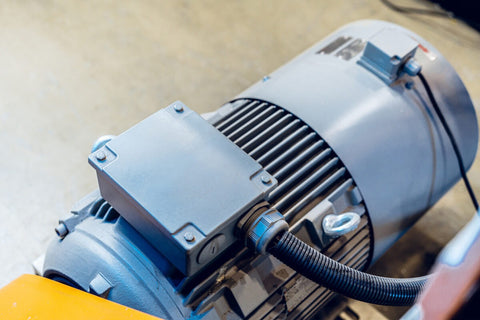The Short Answer: What is an air compressor? Put simply, an air compressor is a device specifically engineered to convert power (from an electric motor, diesel or gasoline engine, etc) into potential energy, stored as compressed air. This trapped, pressurized air can subsequently serve many purposes across numerous industries. From inflating tires to powering pneumatic tools in construction projects, and even propelling underwater divers, the utility of an air compressor is extensive and diverse.
Now, while this sums up the basic understanding, air compressors are quite complex in their design and operation. In this blog, we delve deeper into the world of air compressors: how they work, the different types including their specific uses, understanding key features and specifications, and ultimately, how Advanced Air & Vacuum can support you in selecting the right compressor for your needs.
Understanding Air Compressors
The Basics of Air Compression
If you’ve ever wondered what an air compressor does, the answer lies in its name. As previously mentioned, an air compressor works on the principle of converting power into potential energy. This is achieved primarily through an electric motor, though other power sources like combustion engines could be utilized depending on the particular usage requirements.

The Process of Air Compression
Here is where we take a look into how an air compressor operates. The process unfolds in several stages. First, atmospheric air is drawn into the air system – not unlike inhaling a breath of fresh, ambient air. Once this air is brought inside the machine, it finds itself in the compressor, a mechanical device that compresses or shrinks the air volume. When the volume of the air diminishes, the air’s pressure escalates, enabling the conversion of kinetic energy into potential energy.
Energy Storage & Deployment
Following compression, the now pressurized air is moved into a storage tank. The pressure heightens as more air is packed into the tank until it reaches capacity. A pressure switch then alerts the electric motor or other power source to discontinue operation. The high-pressure air rests within the tank, like a coiled spring waiting to be released, its potential energy ready to be utilized.
The final transformation occurs when the air is deployed. As it is discharged from the tank, the pressure rapidly plummets, and the potential energy reverts to kinetic energy. This energy is used to power various tools and applications from the plasma cutter in a fabrication shop to the tire inflator at your local auto shop. With its multifaceted applications, the air compressor is a remarkable piece of machinery.
Air Compressor Key Terms
Understanding Key Terms
When selecting an air compressor, it’s essential to be familiar with key terms and specifications such as cubic feet, gallon tank, duty cycle, tank pressure, and tank size. Here is a quick overview:
- Cubic feet per minute (CFM): A measure of the volume of air an air compressor can produce.
- Gallon Tank: Refers to the storage tank size and how much compressed air it can hold.
- Duty Cycle: The measurement of how long an air compressor can run before it needs a rest period. High duty cycle compressors are more robust and suitable for industrial use.
- Tank Pressure: The measure of the pressure of the stored compressed air, and it is typically measured in pounds per square inch (PSI).
- Dryer Filters: These remove moisture from the compressed air, which is essential in applications where dry air is critical, such as in painting or medical applications.
- Oil-Free Compressors: These do not use oil in the compression chamber, making them ideal for applications requiring clean air, like food processing and electronics.
- Dual-Stage Compressors: These compress air in two stages for higher pressure output and increased efficiency, often used in heavy-duty industrial applications.
- Noise Level: The amount of noise produced by the air compressor, typically measured in decibels (dB). Lower noise levels are preferred for indoor or noise-sensitive environments.
Other Air Compressor Features
Beyond the primary considerations, air compressors can come with additional features that enhance their functionality and efficiency. One such feature is a water separator, which removes water from the compressed air. This is particularly crucial in applications where moisture cannot be tolerated, such as in medical environments.
Variable speed drives are another valuable add-on. They adjust the motor’s speed to match the air demand, optimizing energy consumption and contributing to cost savings. More efficient air systems with variable speed drives are not only cost-effective but also better for the environment, aligning with many businesses’ eco-friendly focus.
Different Types & Uses of Air Compressors

Types of Air Compressors
There are various types of air compressors, each designed to meet specific requirements. Among the most commonly used ones are piston compressors, rotary screw compressors, and centrifugal compressors.
Piston compressors, also known as reciprocating compressors, work on the principles of positive displacement. Here, air is sucked into a compartment and then compressed using one or more pistons that move up and down. On the other hand, we have rotary screw compressors which employ twin screws instead of pistons for compression, ideal for continuous use. Lastly, centrifugal compressors are dynamic compressors that produce high-pressure discharge by converting angular momentum from a rotating impeller.
Depending on the amount of power you need and the application at hand, you might even opt for a portable air compressor that allows for easy transport and use in multiple off-site locations.
Uses of Air Compressors
Just as there are different types of compressors, their uses are numerous as well, with roles in both domestic and industrial applications. You can use a small air compressor to perform simple household chores like cleaning hard-to-reach places or more major industrial roles that require advanced air compressors like two-stage compressors.
In industrial applications, compressed air is used throughout the manufacturing process to power pneumatic machinery, assembly, automation, and quality control processes. Air compressors are also a vital tool in the automotive industry. Automotive shops use a compressed air system for spray painting cars, inflating tires, and powering car lifts as well as pneumatic tools.
Air Compressors with Advanced Air & Vacuum
Learning about air compressors can be both fascinating and overwhelming, given their complex mechanisms, numerous types, and wide-ranging applications. Oftentimes, we don’t even realize that air compressors are all around us and a key cog in so many businesses. At Advanced Air & Vacuum, we are dedicated to making this journey simpler for businesses in California, Arizona, and Las Vegas. We provide air system solutions tailored to our customers’ specific needs, whether you are seeking an expert opinion on what air compressor makes the most sense for your operations or need an old air compressor repair. Our sales and services cover air compressors, vacuum pumps, air compressor pumps, air compressor motors, and Prevost air piping, a testament to our comprehensive approach to meeting all of your air system needs.


